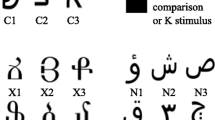Abstract
Twenty college students were randomly assigned to 2 groups. Dependent variables were presses on a touch screen, reaction time, and number of errors during training. An index of consistent responding to comparison stimuli during testing for equivalence was calculated. The subjects were also presented with a postexperimental task in which they sorted symbols used in the experiment. The main finding was that the many-to-one training structure was superior in producing equivalence outcome as compared to the one-to-many structure. There are indices that the 2 groups did not differ with respect to naming strategies. Reaction time measures differed in the 2 groups during the mix training but not during equivalence trials.
Similar content being viewed by others
References
ARNTZEN, E., & HOLTH, P. (1997). Probability of stimulus equivalence as a function of training design. The Psychological Record, 47, 309–320.
ARNTZEN, E., & HOLTH, P. (2000). Equivalence outcome in single subjects as a function of training structure. The Psychological Record, 50, 603–628
BARNES, D. (1994). Stimulus equivalence and relation frame theory. The Psychological Record, 44, 91–124.
BENTALL, R. P, DICKENS, D. W., & FOX, S. R. (1993). Naming and equivalence: Response latencies for emergent relations. The Quarterly Journal of Experimental Psychology, 46B, 187–214.
BENTALL, R. P., JONES, R. M., & DICKENS, D. W. (1999). Error and response latencies as a function of nodal distance in 5-member equivalence classes. The Psychological Record, 49, 93–115.
DUGDALE, N., & LOWE, C. F. (1990). Naming and stimulus equivalence. In D. E. Blackman & H. Lejeune (Eds.), Behavior analysis in theory and practice: Contributions and controversies (pp. 115–138). Hillsdale, NJ: Erlbaum.
EIKESETH, S., & SMITH, T. (1992). The development of functional and equivalence classes in high-functioning autistic children: The role of naming. Journal of the Experimental Analysis of Behavior, 58, 123–133.
FIELDS, L., ADAMS, B. J., NEWMAN, S., & VERHAVE, T. (1992). Interaction among emergent relations during equivalence class formation. The Quarterly Journal of Experimental Psychology, 45B, 125–138.
FIELDS, L., & VERHAVE, T. (1987). The structure of equivalence classes. Journal of the Experimental Analysis of Behavior, 48, 317–332.
FIELDS, L., VERHAVE, T., & FATH, S. (1984). Stimulus equivalence and transitive associations: A methodological analysis. Journal of the Experimental Analysis of Behavior, 42, 143–157.
HOLTH, P., & ARNTZEN, E. (1998). Stimulus familiarity and the delayed emergence of stimulus equivalence or consistent nonequivalence. The Psychological Record, 48, 81–110.
HOLTH, P., & ARNTZEN, E. (2000). Reaction times and the emergence of class consistent responding: A case for precurrent responding? The Psychological Record, 50, 305–337.
HORNE, P. J., & LOWE, C. F. (1996). On the origin of naming and other symbolic behavior. Journal of the Experimental Analysis of Behavior, 65, 185–241.
SAUNDERS, R. R., & GREEN, G. (1999). A discrimination analysis of training structure effects on stimulus equivalence outcomes. Journal of the Experimental Analysis of Behavior, 72, 117–137.
SAUNDERS, K. J., SAUNDERS, R. R., WILLIAMS, D. C, & SPRADLIN, J. E. (1993). An interaction of instruction and training design on stimulus class formation: Extending the analysis of equivalence. The Psychological Record, 43, 725–744.
SAUNDERS, R. R., WACHTER, J. A., & SPRADLIN, J. E. (1988). Establishing auditory stimulus control over an eight-member equivalence class via conditional discrimination procedure. Journal of the Experimental Analysis of Behavior, 49, 95–115.
SIDMAN, M. (1994). Equivalence relations and behavior: A research story. Boston: Authors Cooperative.
SIDMAN, M., & TAILBY, W. (1982). Conditional discrimination vs. matching to sample: An expansion of the testing paradigm. Journal of the Experimental Analysis of Behavior, 37, 5–22.
SPENCER, T. J., & CHASE, P. N. (1996). Journal of the Experimental Analysis of Behavior, 65, 643–659.
SPRADLIN, J. E., & SAUNDERS, R. R. (1986). The development of stimulus classes using match-to-sample procedure: Sample classification versus comparison classification. Analysis and Intervention in Developmental Disabilities, 6, 41–58.
URCUIOLI, P. C., & ZENTALL, T. V. (1993). The test of comparison-stimulus substitutability following Otm matching by pigeons. The Psychological Record, 43, 645–759.
Author information
Authors and Affiliations
Corresponding author
Additional information
The study was conducted at University of Oslo, Norway. Oddbjørn Hove is currently at Heise Fonna HF, Rehabilitation Service for Adult and Children, Norway.
The author thanks Per Holth for helpful comments on an earlier draft of this paper.
Rights and permissions
About this article
Cite this article
Hove, O. Differential Probability of Equivalence Class Formation Following a One-To-Many Versus a Many-To-One Training Structure. Psychol Rec 53, 617–634 (2003). https://doi.org/10.1007/BF03395456
Published:
Issue Date:
DOI: https://doi.org/10.1007/BF03395456




